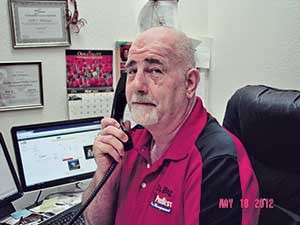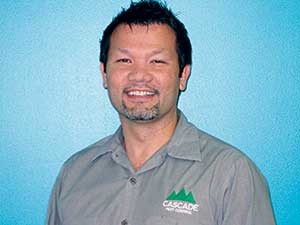Our industry is slowly, but surely seeing the benefits of online training for rookie and veteran employees alike.
Using computers to train for an occupation as physical as pest management may sound pointless, but it’s not — especially for learning to identify the biology and behavior of various pests. It’s a training component that’s increasing in popularity, especially as a generation of employees raised on digital technology enters the work force.

Dr. Nancy Troyano. Photos: Rentokil USA
In fact, online is Rentokil North America’s primary method for delivering training to technicians, sales and office staff. That’s according to Dr. Nancy Troyano, BCE, the company’s Allentown, Pa.-based entomologist/director of technical education and training.
“Having well educated technicians correlates with service quality, so why not provide technicians with some of the best training tools available?” she says. “All of our new technicians go through a rigorous training program, much of which is accessed online. On their first day of work, technicians are provided with a username and password — and a world of education awaits them at login.”
Once their initial training is complete, Dr. Troyano says, Rentokil NA technicians continue to receive monthly online training as part of their continuing education and development.
Don Leland, general manager of Redmond, Wash.-based Cascade Pest Control, reports that, five years ago, when he and Co-Owner Kurt Treftz couldn’t find what they were looking for in an industry online training program, they decided to create their own. Thus “Cascade University” was born.
“In the state of Washington, every individual has to have his or her own license,” he explains. “Using the platform of Google Forms online, our employees can study and take practice exams.”
Leland admits, the first version of Cascade U was pretty rudimentary.
“The user picks an answer, and the computer displays why this is or isn’t the correct answer,” he says. But he and Treftz continue to fine-tune the program, which now features PDFs and video-based quizzes.
“Ultimately, each training session ends with a score, and then we track each time a person takes it, to see how much more study someone needs to focus on what areas,” Leland says. “Our market is very technology driven, so it’s difficult to find someone who already has a pest management license.
“When we hire someone who’s green, we have them come in for training consisting of classroom study, lab time and field training, as well as links for them to study at home,” he says.

Keith “Dr. Bug” Birkemeyer. Photo: ProBest Pest Management
Keith “Dr. Bug” Birkemeyer, ACE, was a manufacturer’s rep before purchasing ProBest Pest Management in Gilbert, Ariz., in 2005. As such, he was certified to teach pest management professionals (PMPs) — and still uses his PowerPoint presentations to educate today.
While he doesn’t currently have an in-house online training program, Birkemeyer notes that the industry is fortunate to have distributors, associations, consultants and manufacturers offering continuing education credits, both online and in person.
“Some are free, others have a cost but are well worth the fee,” he says. Birkemeyer encourages ProBest employees to go online for training, “and then we sponsor or host monthly extra credit hours.
“We try to aim for those months that have that extra fifth working week, so we probably end up with about six to 12 hours per year,” he says. “We may also attend AZPPO (Arizona Pest Control Professional Organization) functions or national association events.”
Dr. Troyano reports that Rentokil NA began using online training more than a decade ago.
“At that time, our learning and development team was aware of the potentially great learning tool in the form of e-learning,” she says. “From a business perspective, growing at the rate we were, we also recognized the value of online training. Our learning management system (LMS) allowed us to deliver the same training content to technicians in a wide geographic range, as well as manage and track training for each of those individuals.”
That first program, Dr. Troyano recalls, started out as “a few basic e-learning courses — supplementary to textbooks and paper handouts — but has since become the primary platform of delivery for a comprehensive training program, complete with interactive e-learning courses, videos, e-books, electronic exams, etc.” The LMS also serves as storage for records of completed training, she says.

Photo: ©istock.com/Berezko
The downside
As with any training platform, Dr. Troyano notes, there are drawbacks with online training.
“Two of the biggest issues have to do with equipment and time management,” she says. “Online training requires a reliable computer or mobile device, as well as Internet access. While having these items may sound like a no-brainer in this day and age, they are often not available to everyone and in all locations.
“Another challenge is that it can be difficult to manage when and how much training someone takes,” Troyano says. “When all of the training is readily accessible online, sometimes employees wind up taking many courses back-to-back over a short span of time. When this happens, the amount of information one actually retains is questionable.”
To combat these issues, Dr. Troyano says, Rentokil NA provides a detailed schedule with timeframes for course completion. This gives employees a time cushion if equipment isn’t readily available, yet spaces the sessions out enough that “cramming” the information isn’t an option.
“During their first few months, new technicians spend about seven hours per week online,” says Dr. Troyano. “After initial training, but still in the first year of hire, our technicians are also expected to complete a college-level online correspondence course, where they spend about one to two hours a week online over five months. Fully trained technicians probably spend about 20 hours or more annually doing online training as part of their continuous education and development.”
ProBest’s Birkemeyer encourages training above and beyond industry contributors. His insurance agent, Mary Contreras, gives a presentation to employees annually on accident avoidance, speeding and others vehicle safety topics. Contreras reinforces her training program throughout the year with an online component.
“My chiropractor also stops by occasionally to discuss the things that can get you in trouble with your body and bones,” Birkemeyer says. “It’s not just about great employees. Surround yourself with people who know things different than yourself — like your insurance agent, chiropractor or wellness experts. They can be a wealth of great information. Look outside that box, use online, in person or anything you can think of to assist you in promoting great employees.”
Leland agrees that looking beyond the obvious when training is as valuable as it is necessary.
“A lot of WSPMA (Washington State Pest Management Association) training is down in Tacoma, which isn’t a huge drive but is still a couple hours on the road round-trip,” he says. “In light of that, our strategy has really been to get speakers here. We continue to look for opportunities, and also look to design our own courses and get approved.”
“Integrated pest management (IPM) revolves around knowing the biology and behavior of the pest, and the answer to solving most problems is going to come from a book, not a spray container,” Dr. Troyano says.
“But while it is impractical for a technician to carry a textbook into a customer’s account — not to mention, they’d probably look pretty silly — they can discreetly carry a mobile phone with them, and can use it to instantly access information online. The information they need may come from an online book, pest ID app or perhaps a short how-to video.”
Training on the front lines
When a potential customer calls your office and says, “I want to talk to a technician who knows what he’s doing,” can everyone in the room be qualified to take the call? At Cascade Pest Control in Redmond, Wash., they can.

Cascade Pest Control’s Don Leland is a co-creator of “Cascade U. Photo: Cascade Pest Control
“We offer our office and sales staff a $500 incentive to become licensed,” says General Manager Don Leland. “It helps offer credibility, and the ability to help the caller immediately.”
Doug Foster, owner of Burt’s Termite & Pest Control, Columbus, Ind., agrees that while the inside team doesn’t necessarily need to be as technically savvy as the field crew, the more they know, the better.
“They need to know the basics so customers don’t think they’re just getting an answering service when they call,” Foster says. “We want our office staff to know the technical end, plus we have additional training, such as how to handle a rude customer, how to handle a disrespectful customer, and scheduling.”
Foster occasionally even sends his office and sales crew to mediation training seminars, as they become available. “Dealing with confrontations on the phone, some of the stuff that goes on in offices — things like that,” he says. “I think we as an industry sometimes forget that even though we’re in pest control, we’re also a business. Our staff needs to know not only how to handle certain situations, but be able to give people basic pest control knowledge and know how to handle different situations on the phone.”
You can reach PMP Editor Heather Gooch at hgooch@northcoastmedia.net or 330-321-9754.
Leave A Comment